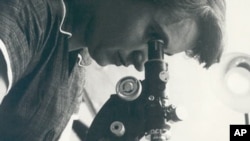Many people have never heard of British scientist Rosalind Franklin. Her research helped solve the mystery of the structure of DNA - the building blocks of life. In 1952, Franklin took X-Ray photographs of a molecule that showed DNA contains two strands wrapped around each other in a double helix, like a twisted ladder. The clearest image, known as photograph 51, enabled other scientists to build a model of DNA, and they received credit for it.
In Washington, a play at the Jewish Community Center called “Photograph 51” depicts Franklin as the only woman doing DNA research then in a man’s world. The play coincides with women's history month in the US.
It’s a magical moment in “Photograph 51.” Scientist Rosalind Franklin sees the double helix of a DNA molecule.
Franklin was a chemist with a doctorate from Britain's Cambridge University. It was the early 1950s. She was in her 30s when she was working on DNA research.
The play shows Franklin working tirelessly and mostly independently on her research. She often clashed with male colleagues who she felt treated her dismissively.
“She wasn’t called Dr. Franklin, she was called Miss Franklin. She wasn’t allowed to eat in the senior common room; all the men were allowed to eat in the senior common room. That absolutely crippled her and created an environment where she didn’t trust the people she was working with,” said Daniella Topol, the director of the play.
Franklin tried to figure out how the double helix worked but wasn’t able to. Without her permission, Franklin’s co-worker, Maurice Wilkins, secretly showed her photos to American scientist James Watson. He and Francis Crick, his British research partner, were trying to build a DNA model. When Watson saw the photographs, he realized that DNA is a double-stranded helix and the two were able to complete the model.
Franklin learned about their breakthrough from her colleague Wilkins.
In 1962, Crick, Watson, and Wilkins received the Nobel Prize in Medicine. It was four years after Franklin had died from cancer, at the age of 37. The award is given only to people who are alive.
During the ceremony, no credit was given to Franklin. And Watson has largely dismissed her role. But Crick, who died in 2004, has said Franklin was only “two steps away” from solving the DNA puzzle.
Topol hopes people who see the play will not only learn about Franklin but will have a better understanding of her. “I want people to think about everything Rosalind Franklin accomplished, and how much more she could have accomplished had she not been isolated and marginalized and misunderstood and discriminated against,” she said.
Franklin was a pioneer, whose valuable DNA photograph helped change the world of genetics forever.






